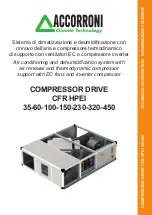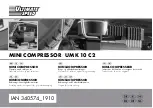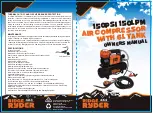
ENGLISH
en
9
– Ensure that all compressed air tools and
accessories used are designed for the working
pressure or can be connected via a pressure
reducer.
– When loosening the quick coupling pay
attention that the compressed air contained in
the compressed air hose escapes suddenly.
Therefore get a firm grip of the end of the
compressed air hose to be loosened.
– Ensure that all screwed connections are always
tightened properly.
– Do not attempt to repair the pump yourself! Only
professionals may carry out repairs on
compressors, compressed containers and
compressed air tools.
4.2 Risk of burns at the surfaces of the
parts bearing compressed air!
– Let the tool cool down prior to the servicing
work.
4.3 Risk of personal injury and
crushing by moving parts!
– Do not operate the tool without installed guards.
– Keep in mind that the tool starts up
automatically when the minimum pressure is
reached! – Ensure the tool is disconnected from
power before servicing.
– Ensure that when switching on (e.g. after
servicing) no tools or loose parts are left on or in
the tool.
4.4 Hazard generated by insufficient
personal protection gear!
– Wear hearing protection.
– Wear safety glasses.
– Wear a breathing mask for applications
generating dust or when harmful gases, mist or
vapours are generated.
– Wear suitable work clothes.
– Wear non-slip footwear.
4.5 Hazard generated by machine
defects!
– Keep tool and accessories in good repair.
Observe the maintenance instructions.
– Before every use check tthe machine for
possible damage: before operating the machine
all safety devices, protective guards or slightly
damaged parts need to be checked for proper
function as specified. A damaged device must
only be reused after it has been correctly
repaired.
– Check to see that all moving parts work properly
and do not jam. All parts must be correctly
installed and fulfil all conditions necessary to
ensure perfect operation of the unit.
– Damaged protection devices or parts must be
repaired or replaced by a qualified specialist.
4.6 Specialised safety instructions for
cordless devices
– Remove the battery pack from the device before
making any adjustments, changing tools,
maintaining or cleaning.
Protect battery packs from water and
moisture!
Do not expose battery packs to fire!
– Do not use faulty or deformed battery packs!
– Do not open battery packs!
– Do not touch or short circuit battery pack
contacts!
A slightly acidic, flammable fluid may leak
from defective Li-ion battery packs!
If battery fluid leaks out and comes into
contact with your skin, rinse immediately
with plenty of water. If battery fluid leaks
out and comes into contact with your eyes, wash
them with clean water and seek medical attention
immediately!
– If the machine is defective, remove the battery
pack from the machine.
Transport of li-ion battery packs:
– The shipping of li-ion battery pack is subject to
laws related to the carriage of hazardous goods
(UN 3480 and UN 3481). Inform yourself of the
currently valid specifications when shipping li-
ion battery packs. If necessary, consult your
freight forwarder. Certified packaging is
available from Metabo.
– Only send the battery pack if the housing is
intact and no fluid is leaking. Remove the
battery pack from the machine for sending.
Prevent the contacts from short-circuiting (e.g.
by protecting them with adhesive tape).
4.7 Additional Safety Instructions
– Please also observe the special safety
instructions in the respective chapters.
– Observe any particular health and safety or
accident prevention regulations governing the
use of compressors and compressed air tools.
– Observe the legal provisions for the operation of
systems requiring monitoring.
– Keep in mind that escaping condensate and
other consumables contaminate the
surrounding area and may trigger damage to the
environment during operation and storage of the
tool.
– Consider environmental conditions:
4.8 Symbols on the machine
(depends
on model)
Read instructions.
Warning of personal injury by touching hot
parts.
Wear eye goggles
Wear ear protectors.
Warning of automatic startup.
Danger - electrical voltage.
Guaranteed sound power level.
4.9 Safety Devices
Safety valve
The spring-loaded valve (8) reacts if the permitted
maximum pressure is exceeded.
See page 2.
1 connection for compressed air (quick
coupling), regulated compressed air
2 pressure regulator
3 manometer boiler pressure
4 manometer control pressure
5 Capacity indicator button *
6 Capacity and signal indicator *
7 ON/OFF Switch
8 safety valve
9 pressure vessel
10 condensate outlet
11 Battery pack mount (for storing a replacement
battery pack)
12 Battery pack release button
13 Battery pack *
14 Transportation handle
* depending on model/equipment/not in scope of
delivery
6.1 Check condensate outlet
Ensure that the condensate outlet (10) is closed.
6.2 Installation
The positioning site of the device has to meet the
following requirements:
– Dry, protected from frost
– Stable, horizontal and even surface
Danger!
Wrong positioning might cause serious accidents.
– Secure the device against rolling away, tilting
and slipping.
– Safety installations and operating elements
have to be easily accessible at any time.
6.3 Transport
– Do not pull the device from the hose. Transport
the device at the transport handle (14).
7.1 Battery pack
Charge the battery pack before use.
Recharge the battery pack if performance
diminishes.
Instructions on charging the battery pack can be
found in the operating instructions of the Metabo
charger.
In case of Li-Ion battery packs with capacity and
signal display (6) (equipment-specific):
– Press the button (5), the LEDs indicate the
charge level.
– The battery pack is almost flat and must be
recharged if one LED is flashing.
Removing and inserting the battery pack
Danger!
Make sure that the tool is switched off before
fitting the battery pack.
Removal: Press the button to unlock the battery
pack (12) and pull out the battery pack (13) to the
rear.
To insert: Slide the battery pack (13) in until it
engages.
Note: You can store a replacement battery pack
(11) on the battery pack storage mount.
7.2 Generate compressed air
1. Switch on the device using the ON/OFF switch
(7) and wait, until the maximum boiler
pressure has been reached (compressor
switches off). The boiler pressure is shown at
the boiler pressure manometer (3) .
Set the control pressure at the pressure reducer
(2) . The current control pressure is shown at the
control pressure manometer (4).
Attention!
The set control pressure must not exceed the
maximum operating pressure of the connected
compressed air tools!
2. Connect the compressed air hose at the
compressed air inlet (1) .
3. Connect the compressed air tool. Now you
can work with the compressed air tool.
4. Switch off the device if you will not be
continuing work immediately. Then remove
the battery pack as well.
5. Drain the condensed water of the pressure
vessel at the condensate outlet (10) on a daily
basis.
Danger!
Prior to all servicing:
switch machine OFF; Remove battery pack. Wait
until the device has stopped. Ensure that there is
no more pressure on the device and all used
compressed air tools and accessories.
5. Overview
6. Commissioning
7. Operation
8. Care And Maintenance










































